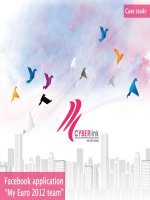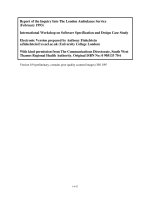Case study ESSS milestone 12 object design
Bạn đang xem bản rút gọn của tài liệu. Xem và tải ngay bản đầy đủ của tài liệu tại đây (128.38 KB, 3 trang )
SADM 7/ed – ESSS CASE STUDY - Milestone 12: Object Design
Page: 12-1
ESSS
MILESTONE 12 – OBJECT DESIGN 1
Synopsis
n performing object-oriented analysis (Milestone 7) we identified objects and use cases based
on ideal conditions and independent of any hardware or software solution. During objectoriented design we want to refine those objects and use cases to reflect the actual environment
of our proposed solution.
Objectives
After completing this milestone, you should be able to:
Transform a requirements use case to a design use case.
Construct a sequence diagram to model the detailed object interactions for a use case.
Transform an analysis class diagram into a partial design class diagram for a use case.
Construction a State Machine diagram for an object that changes states.
Prerequisites
Before starting this milestone the following topics should be covered:
1.
2.
3.
4.
Modeling System Requirements With Use Cases – Chapter 7
Object-Oriented Analysis and Modeling Using the UML – Chapter 10
Object-Oriented Design and Modeling Using the UML – Chapter 18
Milestone 7 Solution
Assignment
In this assignment we will begin with the analysis use case and class diagram from Milestone 7
and transform them into various design models to reflect the targeted production environment.
1
This milestone is only feasible if combined with Milestone 7 Object Analysis.
Prepared by Gary B. Randolph for
Systems Analysis & Design Methods 7ed
by J. L. Whitten & L. D. Bentley
Copyright Irwin/McGraw-Hill 2007
SADM 7/ed – ESSS CASE STUDY - Milestone 12: Object Design
Page: 12-2
Activities
1. Transform the Search Employee Directory requirements use case narrative from Milestone 3 to
a design use case and the narrative provided in Exhibit 12.1 Make assumptions where
necessary.
2. Construct a sequence diagram for the Search Employee Directory use case. Make assumptions
where necessary.
3. Construct a partial design class diagram. Use only objects from the class diagram from
Milestone 7 that are relevant to the use case. Add control and interface objects from your
sequence diagram as necessary. Add the behaviors discovered in constructing the sequence
diagram. Make assumptions where necessary.
4. Construct a state machine diagram that depicts the life of the Employee object through the
states of hired, quit/dismissed, and retired using the narrative in Exhibit 12.1.
Deliverable format and software to be used are according to your instructor’s specifications.
Deliverables should be neatly packaged in a binder, separated with a tab divider labeled
“Milestone 12” and accompanied with a Milestone Evaluation Sheet.
References:
Milestone 3 & 7 Solutions
Provided by your instructor.
View Unresolved Requests Narrative
Exhibit 12.1
Templates
See on-line learning center website for the textbook.
Deliverables:
Design Use Case:
Due: __/__/__
Time: _______
Sequence Diagram:
Due: __/__/__
Time: _______
Design Class Diagram:
Due: __/__/__
Time: _______
State Machine Diagram:
Due: __/__/__
Time: _______
Milestone’s Point Value:
Prepared by Gary B. Randolph for
Systems Analysis & Design Methods 7ed
by J. L. Whitten & L. D. Bentley
_______
Copyright Irwin/McGraw-Hill 2007
SADM 7/ed – ESSS CASE STUDY - Milestone 12: Object Design
Page: 12-3
Exhibit 12.1 – Narrative for Employee Object States
An employee is first entered to the system when he or she is hired. If the employee quits or is
dismissed, the employee is considered to be in the quit/dismissed state. Sometimes an employee
who quits or is dismissed will at some point be re-hired. Hired employees can retire. Retired
employees can be re-hired.
Prepared by Gary B. Randolph for
Systems Analysis & Design Methods 7ed
by J. L. Whitten & L. D. Bentley
Copyright Irwin/McGraw-Hill 2007









